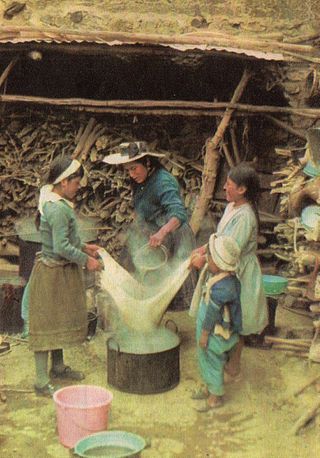Related Research Articles

Dame Millicent Garrett Fawcett was an English political activist and writer. She campaigned for women's suffrage by legal change and in 1897–1919 led Britain's largest women's rights association, the National Union of Women's Suffrage Societies (NUWSS), explaining, "I cannot say I became a suffragist. I always was one, from the time I was old enough to think at all about the principles of Representative Government." She tried to broaden women's chances of higher education, as a governor of Bedford College, London and co-founding Newnham College, Cambridge in 1875. In 2018, a century after the Representation of the People Act, she was the first woman honoured by a statue in Parliament Square.

A governess is a woman employed as a private tutor, who teaches and trains a child or children in their home. A governess often lives in the same residence as the children she is teaching. In contrast to a nanny, the primary role of a governess is teaching, rather than meeting the physical needs of children; hence a governess is usually in charge of school-aged children, rather than babies.

Sati or suttee was a Hindu historical practice in which a widow sacrifices herself by sitting atop her deceased husband's funeral pyre. It has been linked to related Hindu practices in regions of India. Greek sources from around c. 300 BCE make isolated mention of sati, but it likely developed into a real fire sacrifice in the medieval era within northwestern Rajput clans to which it initially remained limited, to become more widespread during the late medieval era.

Petronilla, whose name is also spelled Petronila or Petronella, was Queen of Aragon (1137–1164) from the abdication of her father, Ramiro II, in 1137 until her own abdication in 1164. After her abdication she acted as regent during the minority of her son Alfonso II of Aragon (1164–1173). She was the last ruling member of the Jiménez dynasty in Aragon, and by marriage brought the throne to the House of Barcelona.
Lady is a term for a woman who behaves in a polite way. Once used to describe only women of a high social class or status, the female counterpart of lord, now it may refer to any adult woman, as gentleman can be used for men.
Matilda was Countess of Boulogne in her own right from 1125 and Queen of England from the accession of her husband, Stephen, in 1135 until her death in 1152. She supported Stephen in his struggle for the English throne against their mutual cousin Empress Matilda. She played an unusually active role for a woman of the period when her husband was captured, and proved herself an effective general who managed to force the Empress to release Stephen. Under the agreement that settled the civil war, the Queen's children did not inherit the English throne; however, her three surviving children ruled Boulogne in turn as Eustace IV, William I, and Marie I.

Divorce according to Islamic law can occur in a variety of forms, some initiated by a husband and some by a wife. The main categories of Islamic customary law are talaq, khulʿ and faskh. Historically, the rules of divorce were governed by sharia, as interpreted by traditional Islamic jurisprudence, though they differed depending on the legal school, and historical practices sometimes diverged from legal theory.

The Women's Tax Resistance League (WTRL) was from 1909 to 1918 a direct action group associated with the Women's Freedom League that used tax resistance to protest against the disenfranchisement of women during the British women's suffrage movement.

John Rykener, also known as Eleanor, was a 14th-century sex worker arrested in December 1394 for performing a sex act with John Britby, a man who was a former chaplain of the St Margaret Pattens church, in London's Cheapside while wearing female attire. Although historians tentatively link Rykener, who was male, to a prisoner of the same name, the only known facts of the sex worker's life come from an interrogation made by the mayor of London. Rykener was questioned on two offences: prostitution and sodomy. Prostitutes were not usually arrested in London during this period, while sodomy was an offence against morality rather than common law, and so pursued in ecclesiastical courts. There is no evidence that Rykener was prosecuted for either crime.
Agnes of Essex, Countess of Oxford was the daughter of a royal constable Henry of Essex and his first wife, Cecily. At the age of three she was betrothed to Geoffrey de Vere, brother of the first Earl of Oxford, and turned over to be raised by the Veres soon thereafter. She remained in the household of the earl of Oxford about three years, then moved to Geoffrey's care. In her eleventh year Agnes rejected the match with Geoffrey and by early 1163 was married to his eldest brother Aubrey de Vere III, 1st Earl of Oxford, as his third wife.

Agnes of Antioch, also known as Anna of Antioch and Anne de Châtillon, was Queen of Hungary from 1172 until 1184 as the first wife of Béla III.

A fishwife, fish-fag or fishlass is a woman who sells fish. She is typically the wife of a fisherman, selling her husband's catch, but other sources of fish have been used.
Charlotte Brown Carmichael Stopes, also known as C. C. Stopes, was a British scholar, author, and campaigner for women's rights. She also published several books relating to the life and work of William Shakespeare. Her most successful publication was British Freewomen: Their Historical Privilege, a book which influenced and inspired the early twentieth century British women's suffrage movement. She married Henry Stopes, a palaeontologist, brewer and engineer. They produced two daughters, the eldest of whom was Marie Stopes, known for her advocacy of birth control.

Agnes Salm-Salm was the American wife of Prince Felix zu Salm-Salm, a Prussian mercenary beside whom she played a role in the American Civil War, the Mexican Civil War between President Benito Juárez and the Austrian archduke Maximilian I of Mexico, and the Franco-Prussian War.

Women in the Middle Ages in Europe occupied a number of different social roles. Women held the positions of wife, mother, peasant, artisan, and nun, as well as some important leadership roles, such as abbess or queen regnant. The very concept of women changed in a number of ways during the Middle Ages, and several forces influenced women's roles during this period, while also expanding upon their traditional roles in society and the economy. Whether or not they were powerful or stayed back to take care of their homes, they still played an important role in society whether they were saints, nobles, peasants, or nuns. Due to context from recent years leading to the reconceptualization of women during this time period, many of their roles were overshadowed by the work of men. Although it is prevalent that women participated in church and helping at home, they did much more to influence the Middle Ages.
Sibyl de Neufmarché, Countess of Hereford, suo jure Lady of Brecknock, was a Cambro-Norman noblewoman, heiress to one of the most substantial fiefs in the Welsh Marches. The great-granddaughter of Gruffydd ap Llywelyn, king of Wales, Sibyl was also connected to the nobility of England and Normandy. Sibyl inherited the titles and lands of her father, Bernard de Neufmarché, Lord of Brecon, after her mother, Nest ferch Osbern, had declared her brother Mahel to have been illegitimate. Most of these estates passed to Sibyl's husband, Miles de Gloucester, 1st Earl of Hereford, as her dowry. Their marriage had been arranged personally by King Henry I of England in the spring of 1121. Sibyl, with her extensive lands, was central to the King's plans of consolidating Anglo-Norman power in south-east Wales by the merging of her estates with those of Miles, his loyal subject on whom he relied to implement Crown policy.

Women in early modern Scotland, between the Renaissance of the early sixteenth century and the beginnings of industrialisation in the mid-eighteenth century, were part of a patriarchal society, though the enforcement of this social order was not absolute in all aspects. Women retained their family surnames at marriage and did not join their husband's kin groups. In higher social ranks, marriages were often political in nature and the subject of complex negotiations in which women as matchmakers or mothers could play a major part. Women were a major part of the workforce, with many unmarried women acting as farm servants and married women playing a part in all the major agricultural tasks, particularly during harvest. Widows could be found keeping schools, brewing ale and trading, but many at the bottom of society lived a marginal existence.

Portrait of Maria Pietersdochter Olycan is an oil-on-canvas painting by the Dutch Golden Age painter Frans Hals, painted in 1638, now in the São Paulo Museum of Art. It is considered a pendant to the portrait of Maria's husband Andries van Hoorn.

Women have been active in brewing since ancient times. From the earliest evidence of brewing in 7000 BCE, until the commercialization of brewing during industrialization, women were the primary brewers on all inhabited continents. In many cultures, the deities, goddesses and protectors of brewers were female entities who were associated with fertility.

Agnes Marie Constanze von Hartmann, who wrote under the name A. Taubert, was a German philosopher and writer. She was known for her 1873 book Pessimism and Its Opponents and its contribution to the pessimism controversy in Germany.
References
- ↑ Caroline M. Barron, ‘Women traders and artisans in London (act. c.1200–c.1500)’, Oxford Dictionary of National Biography, Oxford University Press, 2004; online edn, Jan 2008 accessed 23 May 2017
- 1 2 Judith M. Bennett (1996). Ale, Beer, and Brewsters in England: Women's Work in a Changing World, 1300-1600. Oxford University Press. pp. 67–68. ISBN 978-0-19-512650-1.